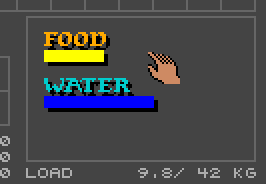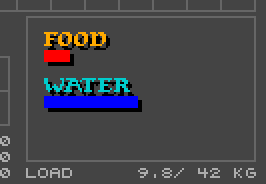Downloads
Executable for the map editor - exactly the same as in part 40 (Windows 32bits)
Executable for the game (Windows 32bits)
Before you try to compile the code go to the "Projects" tab on the left menu, select the "Run" settings for your kit,
and set the "Working directory" to the path of "editor\data" for the editor or "game\data" for the game.
Although there is no change in the editor code in this part, I made an exe of it because the database files changed
a lot since the last time.
Champion's food and water
class CCharacter
{
public:
[...]
int food;
int water;
[...]
}
thirsty and hungry.
#define MIN_FOOD -1024
#define MAX_FOOD 2048
void CCharacter::fromDB(int num)
{
[...]
// food, water
food = 1500 + RANDOM(256);
water = 1500 + RANDOM(256);
These values appear as bars in the character's sheet.

When the value is below 0 the bar appears yellow.

And when it is below -512 the bar appears red.

"Food" and "water" are one of the few texts of the game that are stored as images.
That's a bad habit if you want to translate your game in another language.
All these informations are displayed by the drawFood() function in interface:
void CInterface::drawFood(QImage* image)
{
CCharacter* c = &game.characters[currentChampion];
// frame
CRect frame(CVec2(104, 85), CVec2(218, 157));
graph2D.rect(image, frame, INVENTORY_SLOT_COLOR, false);
// food text
QImage foodText = fileCache.getImage("gfx/interface/Food.png");
graph2D.drawImage(image, CVec2(112, 93), foodText);
int foodSize = ((c->food - MIN_FOOD) * (208 - 113)) / (MAX_FOOD - MIN_FOOD + 1);
if (foodSize > 0)
{
// food bar shadow
QColor foodColor;
if (c->food < -512)
foodColor = RED;
else if (c->food < 0)
foodColor = YELLOW;
else
foodColor = FOOD_COLOR;
CRect rectFoodShadow(CVec2(115, 104), CVec2(115 + foodSize - 1, 109));
graph2D.rect(image, rectFoodShadow, BLACK, true);
// food bar
CRect rectFoodBar(CVec2(113, 102), CVec2(113 + foodSize - 1, 107));
graph2D.rect(image, rectFoodBar, foodColor, true);
}
// water text
QImage waterText = fileCache.getImage("gfx/interface/Water.png");
graph2D.drawImage(image, CVec2(112, 116), waterText);
int waterSize = ((c->water - MIN_FOOD) * (208 - 113)) / (MAX_FOOD - MIN_FOOD + 1);
if (waterSize > 0)
{
// water bar shadow
QColor waterColor;
if (c->water < -512)
waterColor = RED;
else if (c->water < 0)
waterColor = YELLOW;
else
waterColor = WATER_COLOR;
CRect rectWaterShadow(CVec2(115, 127), CVec2(115 + waterSize - 1, 132));
graph2D.rect(image, rectWaterShadow, BLACK, true);
// water bar
CRect rectWaterBar(CVec2(113, 125), CVec2(113 + waterSize - 1, 130));
graph2D.rect(image, rectWaterBar, waterColor, true);
}
}
Food and water decreasing
work just like the ones we had for the mana and health regeneration.
class CCharacter
{
CTimer foodTimer;
CTimer waterTimer;
void CCharacter::fromDB(int num)
{
[...]
// food, water
food = 1500 + RANDOM(256);
water = 1500 + RANDOM(256);
foodTimer.set(FOOD_TIMER, true);
waterTimer.set(WATER_TIMER, true);
void CCharacter::update()
{
[...]
// food, water
if (foodTimer.update() == true)
{
food--;
if (food < MIN_FOOD)
food = MIN_FOOD;
if (interface.isSleeping() == false)
foodTimer.set(FOOD_TIMER, true);
else
foodTimer.set(FOOD_TIMER_SLEEP, true);
}
if (waterTimer.update() == true)
{
water--;
if (water < MIN_FOOD)
water = MIN_FOOD;
if (interface.isSleeping() == false)
waterTimer.set(WATER_TIMER, true);
else
waterTimer.set(WATER_TIMER_SLEEP, true);
}
So we restart them in enterSleep() and exitSleep() too:
//------------------------------------------------------
void CCharacter::enterSleep()
{
[...]
foodTimer.set(FOOD_TIMER_SLEEP, true);
waterTimer.set(WATER_TIMER_SLEEP, true);
}
//------------------------------------------------------
void CCharacter::exitSleep()
{
[...]
foodTimer.set(FOOD_TIMER, true);
waterTimer.set(WATER_TIMER, true);
}
And in turns they had an effect on the stamina, because when they are in the red zone the maximum stamina of the
champion decreased. But we'll talk about that in another part.
Items food and water values
<!-- WATER FLASK -->
<item name="ITEM117">
[...]
<water>1600</water>
</item>
[...]
<!-- APPLE -->
<item name="ITEM120">
[...]
<food>500</food>
</item>
void CObjects::readObjectsDB()
{
[...]
object.food = 0;
object.water = 0;
while(!itemInfo.isNull())
{
[...]
else if (itemInfo.tagName() == "food")
{
object.food = itemInfo.text().toInt();
}
else if (itemInfo.tagName() == "water")
{
object.water = itemInfo.text().toInt();
}
The mouth
First, when the value of food or water is negative, we draw a red frame around it:

void CInterface::drawInventory(QImage* image)
{
[...]
// red frame around the mouth
if (c->food < 0 || c->water < 0)
{
QImage redFrame = fileCache.getImage("gfx/interface/BorderRed.png");
graph2D.drawImage(image, CVec2(55, 45), redFrame);
}
or drink accordingly. So in drawInventory we can add:
if (isResurrecting == false)
{
CRect mouthPosRect(CVec2(56, 46), CVec2(71, 61));
mouse.addArea(eMouseArea_Mouth, mouthPosRect, eCursor_Hand);
}
water field of the character and play a sound.
After that the water flask turns to an empty flask.
The water skin has some charges like a torch. Because we can drink 3 times before it turns to an empty skin.
We'll talk about the initialization of these charges later.
So in CInterface::update() we will call a eat function when we click on the mouse.
// mouth
case eMouseArea_Mouth:
eat();
break;
void CInterface::eat()
{
if (mouse.mObjectInHand.getType() != 0)
{
int objectType = mouse.mObjectInHand.getType();
CObjects::CObjectInfo object = objects.mObjectInfos[objectType];
CCharacter* c = &game.characters[currentChampion];
if (object.food != 0)
{
[...]
}
else if (object.water != 0)
{
if (objectType == OBJECT_TYPE_WATERFLASK)
{
c->water += object.water;
c->water = MIN(c->water, MAX_FOOD);
sound->play(player.pos, "sound/Swallow.wav");
mouse.mObjectInHand.setType(OBJECT_TYPE_EMPTYFLASK);
}
else if (objectType == OBJECT_TYPE_WATERSKIN)
{
c->water += object.water;
c->water = MIN(c->water, MAX_FOOD);
sound->play(player.pos, "sound/Swallow.wav");
int charges = mouse.mObjectInHand.getIntParam("Charges");
charges--;
mouse.mObjectInHand.setIntParam("Charges", charges);
if (charges == 0)
mouse.mObjectInHand.setType(OBJECT_TYPE_WATERSKIN_EMPTY);
}
c->updateLoad();
}
}
}
end of this animation before really eating the object.
This animation is basic. We simply switch between two mouth positions of the sprite sheet that contains the body
parts.

So when we click on the mouth, we will simply start a timer and store the food value we want to add:
void CInterface::eat()
{
[...]
if (object.food != 0)
{
eatValue = object.food;
eatTimer.set(EAT_ANIMATION_TIME, false);
mouse.mObjectInHand.setType(0);
c->updateLoad();
}
finally increment the food field of the character.
// mouth
if (eatTimer.isRunning() == false)
{
if (isResurrecting == false)
{
CRect mouthPosRect(CVec2(56, 46), CVec2(71, 61));
mouse.addArea(eMouseArea_Mouth, mouthPosRect, eCursor_Hand);
}
}
else
{
if (eatTimer.update() == false)
{
// mouth animation
if ((eatTimer.get() / 8) % 2 == 1)
{
CRect imageRect = getItemRect(14);
graph2D.drawImageAtlas(image, CVec2(56, 46), bodyParts, imageRect);
}
}
else
{
// eat at the end of anim
CCharacter* c = &game.characters[currentChampion];
c->food += eatValue;
c->food = MIN(c->food, MAX_FOOD);
sound->play(player.pos, "sound/Swallow.wav");
}
}
Waterskins
So I added this parameter to items.xml, this way you can set it in the editor:
<!-- WATERSKIN (FULL) -->
<item name="ITEM144">
[...]
<water>800</water>
<param type="int">Charges</param>
</item>
So to make sure that this parameter is initialized even for objects that are generated, I set it in the
setDefaultParams() function:
void CObjects::setDefaultParams(CObject* obj)
{
if (obj->getType() == OBJECT_TYPE_TORCH)
{
obj->setIntParam("Charges", TORCH_MAX_CHARGES);
}
else if (obj->getType() == OBJECT_TYPE_WATERSKIN)
{
obj->setIntParam("Charges", WATERSKIN_MAX_CHARGES);
}
}
So I had to write a functions that returns the weight of an object according to this rule and use it everywhere
we used directly the "weight" variable of the CObjectInfo class:
int CObjects::getWeight(CObject* obj)
{
int type = obj->getType();
if (type == OBJECT_TYPE_WATERSKIN)
return mObjectInfos[type].weight - 6 + obj->getIntParam("Charges") * 2;
else
return mObjectInfos[type].weight;
}
to reflect this action on the current load of the character.
Fountains
First we have to add it to walls.xml:
<wall name="Fountain">
<image>Fountain.png</image>
</wall>
void CGame::drawWall(QImage* image, CVec2 mapPos, CVec2 tablePos, EWallSide side, bool flip)
{
[...]
else if (wall->getType() == eWallFountain)
{
//------------------------------------------------------------------------------
// fountain
CRect rect = walls.drawOrnate(image, tablePos, side, ORNATE_FOUNTAIN);
if (tablePos == CVec2(2, 3) && side == eWallSideUp)
mouse.addArea(eMouseAreaG_Fountain, rect, eCursor_Hand, (void*)mapPos.x, (void*)mapPos.y, (void*)playerSide);
}
Note that we also call it for the "fountain lock" that we already had.
else if (clickedArea->type == eMouseAreaG_Fountain)
{
fillOrDrink();
}
We can either fill a water flask or a waterskin.
Or if our hand is empty, the selected champion drinks:
void CGame::fillOrDrink()
{
int type = mouse.mObjectInHand.getType();
if (type == OBJECT_TYPE_WATERSKIN || type == OBJECT_TYPE_WATERSKIN_EMPTY)
{
mouse.mObjectInHand.setType(OBJECT_TYPE_WATERSKIN);
mouse.mObjectInHand.setIntParam("Charges", 3);
}
else if (type == OBJECT_TYPE_EMPTYFLASK)
{
mouse.mObjectInHand.setType(OBJECT_TYPE_WATERFLASK);
}
else if (type == 0)
{
characters[interface.selectedChampion].water = MAX_FOOD;
sound->play(player.pos, "sound/Swallow.wav");
}
}

Bugs
melee attack.
It uses the function getStrength() that needs the weight of the current weapon to compute the strength of the
attack. But we did not pass it the right object.
So combat difficulty should look more like the original game now.
I also fixed a bug that made the program crash when you clicked below the last attack of a weapon.